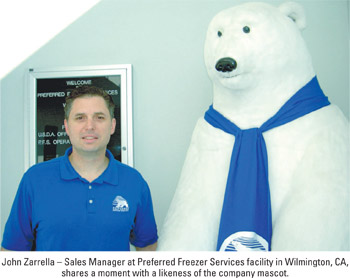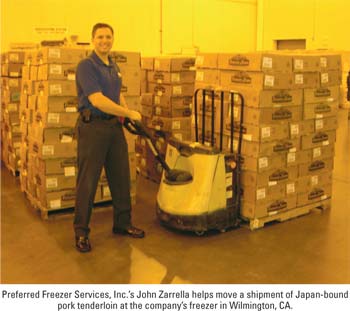By Paul Scott Abbott, AJOTThe strength of the US pork export market is leading to expansion of West Coast freezer facilities to accommodate Asia-bound shipments.
Over the past five years, Newark, N.J.-based Preferred Freezer Services Inc., as part of an aggressive nationwide expansion program, has built three new temperature-controlled warehouses in the Los Angeles area alone.

These new facilities have tripled the firm’s Los Angeles area freezer space to 30 million cubic feet, according to John Zarrella, sales manager at Preferred Freezer’s Wilmington, Calif., facility.
Furthermore, Preferred Freezer looks to break ground this summer on a 12 million-cubic-foot freezer in the Los Angeles County industrial city of Vernon. The facility, with 110-foot-high ceilings and fully automated crane systems, is slated to open in 2009.
While pork exports are not the only impetus behind the freezer boom, they do represent a growing share of the facilities’ volumes. Five years ago, the Wilmington space, which is near the Port of Los Angeles, was almost exclusively handling seafood – Preferred Freezer’s traditional strength. Now, according to Zarrella, 60% of the throughput is non-seafood, much of it being pork headed to Japan.
“We’re exporting more pork, and that’s good,” Zarrella said. “Most all comes in by rail car. It’s cheaper and cleaner to bring it in by rail [as opposed to truck]. You can fit three trucks’ worth on one railcar.”
Only occasionally does pork come to the Preferred Freezer facility by over-the-road truck, with those being shipments arranged by a small-commodity broker who is not moving enough product for railcar transport.

Most of the pork that moves through the facility is interior hog cuts in 30-pound cases, known as 30-pound cushion, Zarrella said. Less-prevalent, value-added pork shipments include those of shoulder cuts and those of loin cuts.
Typically, according to Zarrella, a pork export shipment will consist of hundreds of thousands of pounds.
The growing Asia market not only is spurring Preferred Freezer’s domestic building boom; it also is leading to construction of freezers in Asia. The company recently broke ground on a facility in Ho Chi Minh City, Vietnam, and has a contract to build 30 freezers in China.
While there has been some industry talk that there is an insufficiency of refrigerated container space to accommodate trade, Zarrella said he has not found that to be the case.
“I’ve heard rumblings that there was a container shortage,” he said, “but it hasn’t impacted us.”
 These new facilities have tripled the firm’s Los Angeles area freezer space to 30 million cubic feet, according to John Zarrella, sales manager at Preferred Freezer’s Wilmington, Calif., facility.
Furthermore, Preferred Freezer looks to break ground this summer on a 12 million-cubic-foot freezer in the Los Angeles County industrial city of Vernon. The facility, with 110-foot-high ceilings and fully automated crane systems, is slated to open in 2009.
While pork exports are not the only impetus behind the freezer boom, they do represent a growing share of the facilities’ volumes. Five years ago, the Wilmington space, which is near the Port of Los Angeles, was almost exclusively handling seafood – Preferred Freezer’s traditional strength. Now, according to Zarrella, 60% of the throughput is non-seafood, much of it being pork headed to Japan.
“We’re exporting more pork, and that’s good,” Zarrella said. “Most all comes in by rail car. It’s cheaper and cleaner to bring it in by rail [as opposed to truck]. You can fit three trucks’ worth on one railcar.”
Only occasionally does pork come to the Preferred Freezer facility by over-the-road truck, with those being shipments arranged by a small-commodity broker who is not moving enough product for railcar transport.
These new facilities have tripled the firm’s Los Angeles area freezer space to 30 million cubic feet, according to John Zarrella, sales manager at Preferred Freezer’s Wilmington, Calif., facility.
Furthermore, Preferred Freezer looks to break ground this summer on a 12 million-cubic-foot freezer in the Los Angeles County industrial city of Vernon. The facility, with 110-foot-high ceilings and fully automated crane systems, is slated to open in 2009.
While pork exports are not the only impetus behind the freezer boom, they do represent a growing share of the facilities’ volumes. Five years ago, the Wilmington space, which is near the Port of Los Angeles, was almost exclusively handling seafood – Preferred Freezer’s traditional strength. Now, according to Zarrella, 60% of the throughput is non-seafood, much of it being pork headed to Japan.
“We’re exporting more pork, and that’s good,” Zarrella said. “Most all comes in by rail car. It’s cheaper and cleaner to bring it in by rail [as opposed to truck]. You can fit three trucks’ worth on one railcar.”
Only occasionally does pork come to the Preferred Freezer facility by over-the-road truck, with those being shipments arranged by a small-commodity broker who is not moving enough product for railcar transport.
 Most of the pork that moves through the facility is interior hog cuts in 30-pound cases, known as 30-pound cushion, Zarrella said. Less-prevalent, value-added pork shipments include those of shoulder cuts and those of loin cuts.
Typically, according to Zarrella, a pork export shipment will consist of hundreds of thousands of pounds.
The growing Asia market not only is spurring Preferred Freezer’s domestic building boom; it also is leading to construction of freezers in Asia. The company recently broke ground on a facility in Ho Chi Minh City, Vietnam, and has a contract to build 30 freezers in China.
While there has been some industry talk that there is an insufficiency of refrigerated container space to accommodate trade, Zarrella said he has not found that to be the case.
“I’ve heard rumblings that there was a container shortage,” he said, “but it hasn’t impacted us.”
Most of the pork that moves through the facility is interior hog cuts in 30-pound cases, known as 30-pound cushion, Zarrella said. Less-prevalent, value-added pork shipments include those of shoulder cuts and those of loin cuts.
Typically, according to Zarrella, a pork export shipment will consist of hundreds of thousands of pounds.
The growing Asia market not only is spurring Preferred Freezer’s domestic building boom; it also is leading to construction of freezers in Asia. The company recently broke ground on a facility in Ho Chi Minh City, Vietnam, and has a contract to build 30 freezers in China.
While there has been some industry talk that there is an insufficiency of refrigerated container space to accommodate trade, Zarrella said he has not found that to be the case.
“I’ve heard rumblings that there was a container shortage,” he said, “but it hasn’t impacted us.”





